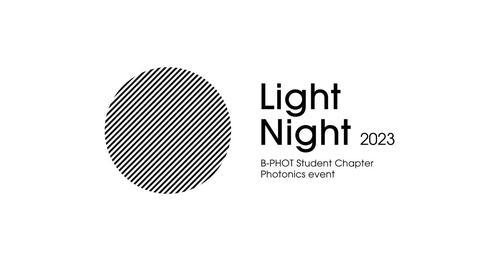#Technical University of Denmark (DTU)
Text
Discover the fascinating world of gravitational waves.

Each year, the B-PHOT Student Chapter celebrates the International Day of Light with their Light Night event. In this year’s edition, you will get the chance to be inspired by Professor Anja Boisen, from the Technical University of Denmark (DTU), who will discuss different biosensing techniques and how light is involved in drug delivery and monitoring.

On top of that, this event will let you discover the fascinating world of gravitational waves via the lecture of Professor Michael Vervaeke and Professor Alexandre Sevrin, both affiliated to the Vrije Universiteit Brussel. Additionally, the B-PHOT Student Chapter will announce the winner of the Photo Contest 2023 at the end of the event, followed by a reception with drinks and food. Light Night 2023 will take place on the 18th of April from 18h to 22h at Pilar Box (VUB campus).
#Light Night event#Technical University of Denmark (DTU)#gravitational waves#belgium#Vrije Universiteit Brussel#Light Night
0 notes
Photo

1.8Pbps: Boffins smash data transmission record • The Register
One laser + one optical chip = more than the traffic of the entire internet
European scientists claim to have achieved a data transmission speed of 1.8 petabits per second, all with a single laser and an optical chip.
For those unsure, 1.8Pbit/s is a lot. As in, more than the total volume of global internet traffic sent every second, the Technical University of Denmark (DTU) said in a statement.
The team credits the characteristics of the frequency comb generated on its chip for the breakthrough, even though it wasn't designed for the purpose.
This is not the first time a frequency comb has been used to help improve the transmission of optical information across a fiber. A group of researchers from the University of California, San Diego, set an especially lengthy record for data transmission in 2015, using the technique to avoid distortion. ...
5 notes
·
View notes
Text
AI forecasts life and death with newfound precision
New Post has been published on https://thedigitalinsider.com/ai-forecasts-life-and-death-with-newfound-precision/
AI forecasts life and death with newfound precision

A new AI system, akin to ChatGPT but developed using the personal stories of over a million people, has demonstrated remarkable precision in forecasting individual life paths and the likelihood of early death, as revealed by a recent study.
This AI was programmed using the personal records of Denmark’s entire population. Researchers from the Technical University of Denmark (DTU) report that it surpasses any current system in predicting death risks.
The team examined health and job market data of 6 million Danish citizens from 2008 to 2020, which included details like educational background, medical visits, diagnoses, income, and job type.
They transformed this information into text to train a sophisticated language model named “life2vec”, utilizing technology similar to that in AI applications like ChatGPT.
After learning the data patterns, the AI was able to outdo other high-tech systems in predicting aspects like personality traits and death timing with notable accuracy, as stated in the Nature Computational Science journal this Tuesday.

The AI was tested on a subset of individuals aged 35-65, half of whom passed away between 2016 and 2020. It successfully predicted who would live or die with 11% greater accuracy than any other AI or method used by life insurance companies.
Sune Lehman from DTU, the study’s lead author, described the novelty of viewing human life as a sequence of events, akin to words forming sentences. He explained that they applied transformer models, typically used in AI, to analyze these ‘life sequences’.
The researchers used the model to estimate the likelihood of a person dying within the next four years.
Their findings aligned with existing research, indicating that those in leadership roles or with higher incomes have better survival chances. Conversely, being male, skilled, or having a mental health diagnosis increases death risk.
Dr. Lehman said, “Our primary interest isn’t the prediction itself but understanding the data elements that enable such precise forecasts.”
The model also more accurately predicted personality test results in a segment of the population than existing AI systems.
Researchers believe their framework could help uncover new mechanisms affecting life outcomes and tailor interventions.
However, they caution against using this model for life insurance purposes due to ethical implications.
Dr. Lehman emphasized that the model’s use by insurance companies would undermine the principle of shared risk, which is fundamental to insurance.
The team also highlighted ethical concerns regarding the use of life2vec, such as data protection, privacy, and bias.
They concluded that while their research showcases the potential of such models, their real-world application should be regulated to safeguard individual rights.

Like what you see? Then check out tonnes more.
From exclusive content by industry experts and an ever-increasing bank of real world use cases, to 80+
deep-dive summit presentations, our membership plans are packed with awesome AI resources.
Subscribe now
Learn more
#ai#applications#Artificial Intelligence#background#Bias#chatGPT#Companies#computational science#data#data protection#details#Events#Explained#framework#Fundamental#Health#how#human#Industry#insurance#it#job market#language#Language Model#leadership#Learn#learning#life#mental health#Method
0 notes
Text
Starter Cultures Market Size 2023 Global Industry Share, Top Players, Opportunities And Forecast To 2033
The worldwide sales of starter cultures, which were previously estimated to be worth around US$ 1,123.1 million in 2022, are now expected to boost up. Currently, in the year 2023, the global starter cultures market value is figured out to be around US$ 1,191.6 million. Further, it is expected to develop with a higher average CAGR of 6.1% over the projected period and reach US$ 2,154.3 million by 2033.
Sales volume of different types of fermented foods has increased over the last decade, creating a lucrative industry of yogurt bacteria culture. The starter market is expected to progress further as a result of the rising dependability of low-fat dairy-based goods and functional beverages.
The market is getting strengthened by changing tastes and preferences and acceptance of packaged dairy products by consumers, along with their rising health concerns. In addition, rising public awareness of the starting culture’s health advantages is anticipated to create new opportunities for the key market players.
Download Report Sample@
https://www.futuremarketinsights.com/reports/sample/rep-gb-16698
Key Takeaways from the Starter Cultures Market Study Report
The demand for starter cultures in the United States market is estimated to be worth around US$ 306 million in the present year 2023.
Whereas, in the Asia Pacific region, China is the leading producer of starter cultures and is anticipated to register a 9.8% CAGR through 2033.
The demand for starter cultures in Germany, with many private companies for packaged food and beverages, is projected to record a 4.5% CAGR through 2033.
The adoption rate of starter cultures in Canada is anticipated to remarkably grow during the forecast years, at a 5% per year rate.
Meanwhile, the mold category of microorganisms for the starter cultures market may register a 5.1% CAGR through the forecast years.
Due to the increased demand for cultured milk products and their use in the production of cheese and butter dairy products, the application segment held the dominant market share in 2022.
Request for Report Customization@
https://www.futuremarketinsights.com/customization-available/rep-gb-16698
Competitive Landscape
Angel Yeast Co Limited, Benny Impex, Biena Snacks, Chr. Hansen Holding A/S, Ingredion Incorporated, CSK Food Enrichment B.V., Danisco A/S, Dohler Group, Dalton Biotechnologies S.R.L., Genesis Laboratories, DuPont’s Nutrition and Biosciences, Lallemand Inc., Meat Cracks Technologies GmbH, Lesaffre Group, Kerry PLC, Mediterranean Biotechnologies Srl. Koninklijke DSM N.V., Meiji Holdings Company Limited, Sacco S.R.L, Mad Millie, Saputo Inc., Wyeast Laboratories Inc., Caldwell Company, Lactina Ltd. Co., Natren Inc., Lb Bulgaricum PLC, and Biocatalysts Limited among others are a few prominent players in the global starter cultures market.
To remain competitive in the market, prominent starter culture market players are focusing on product development according to region-specific requirements. For example, DuPont Danisco LPC 800, Yo-Mix Prime, and Yo-Mix Fast 1.0 are three cultures that Dupont Nutrition and Bioscience Company introduced in January 2020. The conglomerate targeted this product mostly as a solution for yogurt makers in the Chinese market.
Recent Developments
In January 2022, International Flavors & Fragrances (IFF) Company declared an additional outlay for the development of next-generation starting cultures. The company increased its investment to increase the fitness of strains made from plant-based materials, in partnership with the Technical University of Denmark (DTU).
In May 2021, Chr. Hansen Holding A/S Company introduced VEGA, which is a vegan yogurt starter culture kit. The new product consists of starter cultures that can be easily customized as per requirements, and contain probiotic and bioprotective strains.
Ask to Analyst@
https://www.futuremarketinsights.com/ask-question/rep-gb-16698
Key Segments
By Microorganism Type:
Bacteria
Yeast
Mold
Others
By Type:
Lactic Starter Culture
Non-lactic Starter Culture
By Form:
Dried Starter Culture
Liquid Starter Culture
Frozen Starter Culture
By Microorganism Growth Temperature:
Mesophilic Starter Culture
Thermophilic Starter Culture
By Application:
Starter Culture for Dairy and Dairy-based Products
Starter Culture for Meat & Seafood
Starter Culture for Bakery Products
Starter Culture for Alcoholic Beverages
Starter Culture for Non-alcoholic Beverages
Starter Culture for Organic Fertilizers
Starter Culture for Other Applications
By Composition:
Single Strain Starter Culture
Multi-strain Starter Culture
Multi-strain Mix Starter Culture
Other Starter Cultures
Information Source: https://www.futuremarketinsights.com/reports/starter-cultures-market
0 notes
Text

🇩🇰 Crown Prince Frederik of Denmark
Friday, April 28, 2023
“HRH Crown Prince Frederik represented the Danish Royal House at DTU( Technical University of Denmark) Annual Party 2023.”
0 notes
Text
People generate their own oxidation field and change the indoor air chemistry around them
https://sciencespies.com/environment/people-generate-their-own-oxidation-field-and-change-the-indoor-air-chemistry-around-them/
People generate their own oxidation field and change the indoor air chemistry around them
People typically spend 90 percent of their lives inside, at home, at work, or in transport. Within these enclosed spaces, occupants are exposed to a multitude of chemicals from various sources, including outdoor pollutants penetrating indoors, gaseous emissions from building materials and furnishings, and products of our own activities such as cooking and cleaning. In addition, we are ourselves potent mobile emission sources of chemicals that enter the indoor air from our breath and skin.
But how do the chemicals disappear again? In the atmosphere outdoors, this happens to a certain extent naturally by itself, when it rains and through chemical oxidation. Hydroxyl (OH) radicals are largely responsible for this chemical cleaning. These very reactive molecules are also called the detergents of the atmosphere and they are primarily formed when UV light from the sun interacts with ozone and water vapor.
Indoors, on the other hand, the air is of course far less affected by direct sunlight and rain. Since UV rays are largely filtered out by glass windows it has been generally assumed that the concentration of OH radicals is substantially lower indoors than outdoors and that ozone, leaking in from outdoors, is the major oxidant of indoor airborne chemical pollutants.
OH radicals are formed from ozone and skin oils
However, now it has been discovered that high levels of OH radicals can be generated indoors, simply due to the presence of people and ozone. This has been shown by a team led by the Max Planck Institute for Chemistry in cooperation with researchers from the USA and Denmark.
“The discovery that we humans are not only a source of reactive chemicals, but we are also able to transform these chemicals ourselves was very surprising to us,” says Nora Zannoni, first author of the study published in the research magazine Science, and now at the Institute of Atmospheric Sciences and Climate in Bologna, Italy. “The strength and shape of the oxidation field are determined by how much ozone is present, where it infiltrates, and how the ventilation of the indoor space is configured,” adds the scientist from Jonathan Williams’ team. The levels the scientists found were even comparable to outside daytime OH concentrations levels.
advertisement
The oxidation field is generated by the reaction of ozone with oils and fats on our skin, especially the unsaturated triterpene squalene, which constitutes about 10 percent of the skin lipids that protect our skin and keep it supple. The reaction releases a host of gas phase chemicals containing double bonds that react further in the air with ozone to generate substantial levels of OH radicals. These squalene degradation products were characterized and quantified individually using Proton Transfer reaction Mass Spectrometry and fast gas chromatograph-mass spectrometry systems. In addition, the total OH reactivity was determined in parallel enabling the OH levels to be quantified empirically.
The experiments were conducted at the Technical University of Denmark (DTU) in Copenhagen. Four test subjects stayed in a special climate-controlled chamber under standardized conditions. Ozone was added to the chamber air inflow in a quantity that was not harmful to humans but representative of higher indoor levels. The team determined the OH values before and during the volunteers’ stay both with and without ozone present.
In order to understand how the human-generated OH field looked like in space and time during the experiments, results from a detailed multiphase chemical kinetic model from the University of California, Irvine were combined with a computational fluid dynamics model from Pennsylvania State University, both based in the USA. After validating the models against the experimental results, the modeling team examined how the human-generated OH field varied under different conditions of ventilation and ozone, beyond those tested in the laboratory. From the results, it was clear that the OH radicals were present, abundant, and forming strong spatial gradients.
“Our modeling team is the first and currently the only group that can integrate chemical processes between the skin and indoor air, from molecular scales to room scales,” said Manabu Shiraiwa, a professor at UC Irvine who led the modeling part of the new work. “The model makes sense of the measurements — why OH is generated from the reaction with the skin.”
Shiraiwa added that there remain unanswered questions, like the way humidity levels impact the reactions the team traced. “I think this study opens up a new avenue for indoor air research,” he said.
Adapt test methods for furniture and building materials
“We need to rethink indoor chemistry in occupied spaces because the oxidation field we create will transform many of the chemicals in our immediate vicinity. OH can oxidize many more species than ozone, creating a multitude of products directly in our breathing zone with as yet unknown health impacts.” This oxidation field will also impact the chemical signals we emit and receive,” says project leader Jonathan Williams, “and possibly help explain the recent finding that our sense of smell is generally more sensitive to molecules that react faster with OH.”
The new finding also has implications for our health: Currently, chemical emissions of many materials and furnishings are being tested in isolation before they are approved for sale. However, it would be advisable to also conduct tests in the presence of people and ozone, says atmospheric chemist Williams. This is because oxidation processes can lead to the generation of respiratory irritants such as 4-oxopentanal (4-OPA) and other OH radical-generated oxygenated species, and small particles in the immediate vicinity of the respiratory tract. These can have adverse effects, especially in children and the infirm.
These findings are part of the project ICHEAR (Indoor Chemical Human Emissions and Reactivity Project) which brought together a group of collaborating international scientists from Denmark (DTU), the USA (Rutgers University), and Germany (MPI). The modeling was part of the MOCCIE project based at the University of California Irvine and the Pennsylvania State University. Both projects were funded by grants from the A. P. Sloan foundation.
#Environment
#2022 Science News#9-2022 Science News#acts of science#Earth Environment#earth science#Environment and Nature#everyday items#Nature Science#New#News Science Spies#Our Nature#planetary science#production line#sci_evergreen1#Science#Science Channel#science documentary#Science News#Science Spies#Science Spies News#September 2022 Science News#Space Physics & Nature#Space Science#Environment
1 note
·
View note
Text
Danish physicists give the gift of world’s smallest Christmas record—in stereo#Danish #physicists #give #gift #worlds #smallest #Christmas #recordin #stereo
Danish physicists give the gift of world’s smallest Christmas record—in stereo#Danish #physicists #give #gift #worlds #smallest #Christmas #recordin #stereo
The first 25 seconds of a classic Christmas song was inscribed into polymer film using the Nanofrazor 3D lithography system.
Physicists at the Technical University of Denmark (DTU) are bringing the Christmas cheer by using a 3D nanolithography tool called the Nanofrazor to cut the smallest record ever. The tune they “recorded,” in full stereo no less: the first 25 seconds of “Rocking Around the…

View On WordPress
0 notes
Text
L'Infrastruttura europea di comunicazione quantica
Al via la prima rete quantistica europea. Per la prima volta Italia, Slovenia e Croazia sono state connesse stabilmente tramite EuroQci, l’innovativa rete europea per le comunicazioni quantistiche, pilastro della nuova strategia di sicurezza informatica dell'Unione.
Italia, Slovenia e Croazia sono i primi tre paesi europei ad essere stati collegati tramite EuroQci, l’innovativa rete europea per le comunicazioni quantistiche, a cui l’Italia partecipa con il supporto del Consiglio nazionale delle ricerche (Cnr) e delle università di Firenze e Trieste. Lo riporta la rivista Advanced quantum technologies, che ha pubblicato i risultati della prima dimostrazione pubblica di comunicazione crittografata del programma, effettuata con successo durante la riunione dei ministri del G20 sulla digitalizzazione, svoltosi a Trieste nel 2021.

A giugno 2019, i 27 stati membri dell’Unione europea hanno aderito al progetto EuroQCI, firmando la Dichiarazione sull’infrastruttura europea di comunicazione quantistica. L’obiettivo è di rafforzare la protezione delle istituzioni governative europee, dei loro centri dati, degli ospedali, delle reti energetiche e altro ancora, diventando uno dei pilastri principali della nuova strategia di sicurezza informatica dell'Unione per i prossimi decenni.
EuroQci è coordinata dalla Commissione europea per i collegamenti terrestri in fibra ottica e dall’Agenzia spaziale europea (Esa) per i collegamenti satellitari. Il primo servizio attivato è la Quantum key distribution (Qkd), un protocollo in grado di fornire comunicazioni di dati sicure grazie alle leggi della fisica quantistica, proteggendo da potenziali attacchi. Come sottolinea il comunicato diffuso dal Cnr, qualunque tentativo di intercettare la chiave distribuita attraverso Qkd lascerebbe una traccia usabile per rilevare l'intrusione e di agire contro eventuali minacce.
Dopo la prima dimostrazione pubblica del collegamento Qkd, l’iniziativa EuroQci ha preso ufficialmente il via, collegando stabilmente Trieste a Fiume, con un unico collegamento in fibra di 100 chilometri, e a Lubiana, tramite un trusted node a Postumia, cioè un nodo di ripetizione costituito da una coppia ricevitore-trasmettitore Qkd, in cui i fotoni vengono letti fino a ricostruire la chiave, che poi viene trasmessa sul collegamento adiacente. In questo modo, un link Qkd può essere collegato al successivo per realizzare una rete estesa.
La rete è realizzata grazie all'università di Trieste, al gruppo Quantum communications dell'Istituto nazionale di ottica (Ino) del Cnr di Firenze, alla Technical university of Denmark (Dtu) e all’università di Firenze nell'ambito del “Quantum FVG”, progetto finanziato dalla Regione autonoma Friuli Venezia Giulia, dalla facoltà di Matematica e fisica dell'università di Lubiana, dall'Istituto Ruder Bošković e dalla facoltà di Scienze dei trasporti e del traffico di Zagabria. La realizzazione tecnica è stata curata da Qti srl, spin-off del Cnr e società partecipata Telsy, con il supporto di Tim, Sparkle, Telekom Slovenije, Oiv - Digital signals and networks, Stelkom e Lightnet che hanno fornito l’infrastruttura in fibra ottica.
Read the full article
#Croazia#digitalizzazione#Esa#EuroQci#fibraottica#fisicaquantistica#g20#internetquantistico#italia#QKD#Slovenia
0 notes
Text
Researchers set data transfer world record, moving twice the total global Internet traffic in a second
Researchers set data transfer world record, moving twice the total global Internet traffic in a second
Kurt "Cyberguy" Knutsson explains how you can send spam calls to voicemail on an iPhone.
The international group from the Technical University of Denmark (DTU) and Chalmers University of Technology in Sweden used a single light source to transmit 1.8 petabits per second.
In a release, DTU said that they were the first in the world to transmit more than 1 petabit per second – corresponding to 1…

View On WordPress
0 notes
Text
They locate in which parts of the world the emergence of resistance to antibiotics is greater
They locate in which parts of the world the emergence of resistance to antibiotics is greater
Researchers at the National Food Institute of the Technical University of Denmark (DTU) have now mapped out where places in the world the appearance of genes is greater resistance to antibiotics, how they are located and in what types of bacteria they are found.
They have created it by analysis of wastewater samples received by DTU from 243 cities in 101 countries between 2016 and 2019. The…

View On WordPress
0 notes
Text
People generate their own oxidation field and change the indoor air chemistry around them

Sep 02, 2022 15:22 IST
Washington , September 2 (AF): High levels of hydroxyl radicals (OH) can be generated indoors, simply due to the presence of people and ozone.
But how do the chemicals disappear again? In the atmosphere outdoors, this happens to a certain extent naturally by itself, when it rains and through chemical oxidation. Hydroxyl (OH) radicals are largely responsible for this chemical cleaning. These very reactive molecules are also called the detergents of the atmosphere and they are primarily formed when UV light from the sun interacts with ozone and water vapor.
Indoors, on the other hand, the air is of course far less affected by direct sunlight and rain. Since UV rays are largely filtered out by glass windows it has been generally assumed that the concentration of OH radicals is substantially lower indoors than outdoors and that ozone, leaking in from outdoors, is the major oxidant of indoor airborne chemical pollutants.
OH radicals are formed from ozone and skin oils
However, now it has been discovered that high levels of OH radicals can be generated indoors, simply due to the presence of people and ozone. This has been shown by a team led by the Max Planck Institute for Chemistry in cooperation with researchers from the USA and Denmark.
"The discovery that we humans are not only a source of reactive chemicals, but we are also able to transform these chemicals ourselves was very surprising to us," says Nora Zannoni, first author of the study published in the research magazine Science, and now at the Institute of Atmospheric Sciences and Climate in Bologna, Italy. "The strength and shape of the oxidation field are determined by how much ozone is present, where it infiltrates, and how the ventilation of the indoor space is configured," adds the scientist from Jonathan Williams' team. The levels the scientists found were even comparable to outside daytime OH concentrations levels.
The oxidation field is generated by the reaction of ozone with oils and fats on our skin, especially the unsaturated triterpene squalene, which constitutes about 10 percent of the skin lipids that protect our skin and keep it supple. The reaction releases a host of gas phase chemicals containing double bonds that react further in the air with ozone to generate substantial levels of OH radicals. These squalene degradation products were characterized and quantified individually using Proton Transfer reaction Mass Spectrometry and fast gas chromatograph-mass spectrometry systems. In addition, the total OH reactivity was determined in parallel enabling the OH levels to be quantified empirically.
The experiments were conducted at the Technical University of Denmark (DTU) in Copenhagen. Four test subjects stayed in a special climate-controlled chamber under standardized conditions. Ozone was added to the chamber air inflow in a quantity that was not harmful to humans but representative of higher indoor levels. The team determined the OH values before and during the volunteers' stay both with and without ozone present.
In order to understand how the human-generated OH field looked like in space and time during the experiments, results from a detailed multiphase chemical kinetic model from the University of California, Irvine were combined with a computational fluid dynamics model from Pennsylvania State University, both based in the USA. After validating the models against the experimental results, the modeling team examined how the human-generated OH field varied under different conditions of ventilation and ozone, beyond those tested in the laboratory. From the results, it was clear that the OH radicals were present, abundant, and forming strong spatial gradients.
"Our modeling team is the first and currently the only group that can integrate chemical processes between the skin and indoor air, from molecular scales to room scales," said Manabu Shiraiwa, a professor at UC Irvine who led the modeling part of the new work. "The model makes sense of the measurements -- why OH is generated from the reaction with the skin."
Shiraiwa added that there remain unanswered questions, like the way humidity levels impact the reactions the team traced. "I think this study opens up a new avenue for indoor air research," he said.
Adapt test methods for furniture and building materials
"We need to rethink indoor chemistry in occupied spaces because the oxidation field we create will transform many of the chemicals in our immediate vicinity. OH can oxidize many more species than ozone, creating a multitude of products directly in our breathing zone with as yet unknown health impacts." This oxidation field will also impact the chemical signals we emit and receive," says project leader Jonathan Williams, "and possibly help explain the recent finding that our sense of smell is generally more sensitive to molecules that react faster with OH."
The new finding also has implications for our health: Currently, chemical emissions of many materials and furnishings are being tested in isolation before they are approved for sale. However, it would be advisable to also conduct tests in the presence of people and ozone, says atmospheric chemist Williams. This is because oxidation processes can lead to the generation of respiratory irritants such as 4-oxopentanal (4-OPA) and other OH radical-generated oxygenated species, and small particles in the immediate vicinity of the respiratory tract. These can have adverse effects, especially in children and the infirm. (AF)
Read the full article
0 notes
Text
Finnur Pind - Founder at Startup Iceland 2022
Finnur Pind – Founder at Startup Iceland 2022
Finnur has contributed significant advancements in several interrelated fields such as wave based acoustic simulations and virtual acoustics through his career.
Finnur Pind is an acoustics researcher, he studied at the Technical University of Denmark (DTU) and at the building design studio Henning Larsen. He holds a BSc in electrical- and computer engineering from the University of Iceland, a…

View On WordPress
0 notes
Text
(VIDEO) HRH Crown Prince Frederik of Denmark Attends the Danmarks Tekniske Universitet (DTU) Annual Commemoration Day.
(VIDEO) HRH Crown Prince Frederik of Denmark Attends the Danmarks Tekniske Universitet (DTU) Annual Commemoration Day.
On Friday, April 29, 2022, His Royal Highness Crown Prince Frederik of Denmark attended the Danmarks Tekniske Universitet, DTU (Denmark Technical University) annual commemoration ceremony in Lyngby.
The annual commemoration pays tribute to the past year’s academic achievements and celebrates the innovative engineers of the future and the employees who help shape…

View On WordPress
0 notes
Video
youtube
Throwback Thursday: DTU students Anders and Victor take you on a tour of their time in Nepal with the 2018 EWH Institute.
#Technical University of Denmark#DTU#ewhsi#Nepal#tbt#throwback thursday#biomedical engineering#volunteer
1 note
·
View note
Text
New route to Carbon-Neutral Fuels (CNF) from carbon dioxide discovered - Stanford University and Technical University of Denmark (DTU)
New route to Carbon-Neutral Fuels (CNF) from carbon dioxide discovered – Stanford University and Technical University of Denmark (DTU)
Artistic representation of a nickel-based electrode as a broken down fuel pump and of a cerium-based electrode as a new, productive pump. Credit: Cube3D
If the idea of flying on battery-powered commercial jets makes you nervous, you can relax a little. Researchers have discovered a practical starting point for converting carbon dioxide into sustainable liquid fuels, including fuels for…
View On WordPress
#CO2 Conversion#Genesis Nanotechnology#Liquid Fuels#Nanotechnology#Stanford University#Technical University of Denmark (DTU)
2 notes
·
View notes
Photo

Ternary ruthenium complex hydrides can catalyze ammonia synthesis under mild condition
Ammonia is the feedstock for nitrogen fertilizers and thus vital to the sustainable development of society.
Industrial ammonia synthesis catalyzed by Fe or Ru is carried out under high temperature and high pressure with enormous CO2 emission. The development of efficient catalyst enabling ammonia synthesis under mild condition is important.
Recently, a joint research team led by Prof. CHEN Ping from the Dalian Institute of Chemical Physics (DICP) of the Chinese Academy of Sciences (CAS) and Prof. Tejs Vegge from Technical University of Denmark (DTU) has found that ternary complex hydrides of ruthenium and alkali (alkaline earth) metals (i.e., Li4RuH6 and Ba2RuH6) performed well in catalyzing ammonia synthesis under mild condition.
This study was published in Nature Catalysis on Nov. 18.
Read more.
36 notes
·
View notes